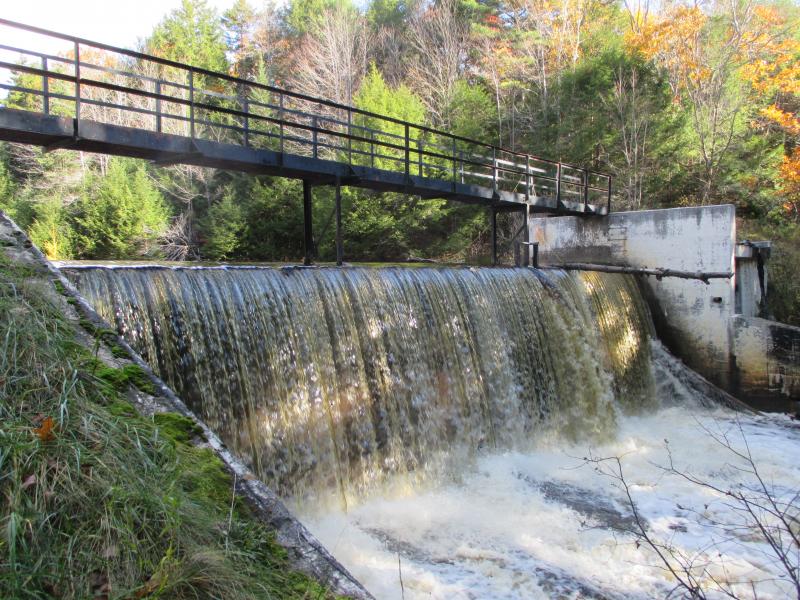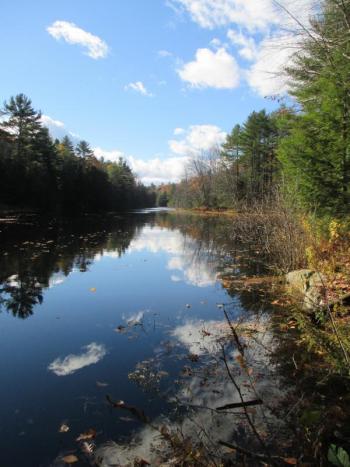Montsweag Dam's future still murky

Water rushing over the concrete dam at the upper end of Montsweag Brook is a pretty sight this time of year surrounded by the golden colors of autumn. The dam situated between Wiscasset and Woolwich has stood here for over a half century but its future has become murky.
The town took on the responsibility of the dam when it accepted a gift of 22 acres from Central Maine Power in March 2013. The land, dam included, was given on the condition it be used for conservation and recreation purposes and came with a gift of $100,000 from the power company to be used for stewardship and monitoring.
The dam was constructed in 1941 as a backup water source for the CMP-owned Mason Station power plant on Birch Point, although the station has long since closed. The triangular-shaped property is heavily wooded and runs parallel to CMP's transmission grid. It stretches from Bradford Road to Freedom Song Lane located off Old Stage Road. Although Wiscasset owns the land, about three acres on the brook's southwestern side are in Woolwich. A good portion of the brook serves as the boundary line between the towns. At some point, Wiscasset will need to share its plans for the property with Woolwich officials.
Wiscasset selectmen tasked the town's Conservation Commission, a committee made up of volunteers and the town planner, with developing recommendations for the property's use. One of the conditions of the transfer of ownership was that the town develop a management plan for the preserve approved by the Department of Environmental Protection.
On Oct. 20, Anne Leslie, chairperson of the Conservation Commission, gave selectmen a draft of the plan, minus a recommendation for the dam. The plan calls for eventually establishing a small parking area; signage and hiking trail around the brook that runs through the center of the property. The preserve's boundaries would be clearly marked as well. Rules for the preserve’s use would have to be established as well but could be modeled on other land preserves or land trusts.
Leslie said the DEP must still approve the management plan. That same evening, selectmen authorized the Conservation Commission to spend up to $2,500 from the preserve's $100,000 stewardship fund to hire a consultant to help in formulating an ecological characterization of the property required as part of the management plan.
What about the Montsweag Dam?
The dam, best reached from Freedom Song Lane, provides access from one side of the property to the other. Before it could ever be included as part of a recreational trail, selectmen will need to weigh the costs of making improvements versus the expense of removing it entirely.
During the summer of 2013, Wright-Pierce Engineering of Topsham conducted an inspection of the dam and spillway. The report included an interview with Tony Fletcher, the state's dam safety inspector, who rated Montsweag Dam as a “low hazard facility.”
In its report to the town, Wright-Pierce offered a number of recommendations. The most significant cost involved concrete repairs estimated to run $30,000 to $45,000. The repairs are needed to address “deep cracking found in the downstream face of the spillway.” The report also recommended replacing the dam's wooden stoplogs, lifted to release water from the impoundment. Two options were given: replacing them with wood or fiberglass for an estimated $12,000; or with steel, for $26,000.
Wright-Pierce’s report stated brush and trees should be cleared from the dam's embankments suggesting the work be carried out by the town's highway department. It also recommended the town restrict access to the steel pedestrian bridge on top of the dam until the 50-foot span was upgraded to meet all applicable safety codes “with respect to toe rails and spacing of side rails.” No price estimate was included for the walkway's upgrade.
The town has since asked Wright-Pierce Engineering to come up with an estimate for the dam's demolition and removal. On Monday, Nov. 2, Jamel Torres, Wiscasset Town Planner, said the town was still awaiting cost estimates for this. Torres told the newspaper he hopes the Wright-Pierce report will be available before Thanksgiving, or by the end of the year at the latest. Costs would obviously be a big factor as far as determining what to do about the dam, he said.
Richard Hanson of Bradford Road has lived upstream from the Montsweag Dam since 1963. At the Oct. 20 selectmen's meeting, he shared pictures of what the area would look like if the dam were removed. Hansen took the pictures during the summer of 1994 when a culvert was replaced on Bradford Road. He said that was the last time the impoundment was completely drained.
“It looked pretty bad, which was about what you'd expect,” he said. Hanson doesn't understand why the town is even considering the dam's removal. “The state inspector of dams looked it over and said it was in good shape structurally. It also provides the fire department with three ponds in this area for fire protection.” Fire protection created by the dam was a major reason why the town accepted the property in the first place, he recalled.
Tim Merry, both a former Wiscasset selectman and fire chief, told selectmen Oct. 20 about a quarter of the town would benefit from the water created by the dam if it were needed in a major fire. Having the fire ponds also benefits homeowners on their insurance, he said.
Hanson hopes selectmen will decide to keep the dam. “This area, which really isn't too far from downtown, is abundant with wildlife. There are ducks, beaver, muskrats and deer here and that's mostly due to the lake and wetlands created by the dam. With the lake gone you really don't have much of a recreational area,” he said.





























